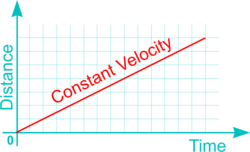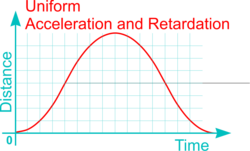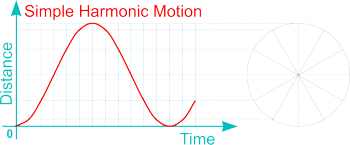Types of Motion: Difference between revisions
From DT Online
(Improved presentation) |
mNo edit summary |
||
| (One intermediate revision by the same user not shown) | |||
| Line 4: | Line 4: | ||
| <span style="color:#B00000"> | | <span style="color:#B00000"> | ||
* Linear Motion is simply motion in a straight line. A measurement of [https://en.wikipedia.org/wiki/Speed '''speed'''] will provide its magnitude ''(i.e. how fast)'' but the term [https://en.wikipedia.org/wiki/Velocity '''velocity'''] gives both speed and direction ''(i.e. it is a [https://en.wikipedia.org/wiki/Euclidean_vector '''vector quantity'''])''</span> | * Linear Motion is simply motion in a straight line. A measurement of [https://en.wikipedia.org/wiki/Speed '''speed'''] will provide its magnitude ''(i.e. how fast)'' but the term [https://en.wikipedia.org/wiki/Velocity '''velocity'''] gives both speed and direction ''(i.e. it is a [https://en.wikipedia.org/wiki/Euclidean_vector '''vector quantity'''])''</span> | ||
| [[File: | | [[File:LinearMotionArrow.png|200px|right]] | ||
|- | |- | ||
| [https://en.wikipedia.org/wiki/Rotation '''Rotational Motion'''] | | [https://en.wikipedia.org/wiki/Rotation '''Rotational Motion'''] | ||
| <span style="color:#B00000"> | | <span style="color:#B00000"> | ||
* Rotational Motion is motion around the circumference of a circle - like the drum of a tumbler dryer or washing machine. Rotational speed is normally measured in revolutions per minute ''(i.e. '''rpm''')'' but [https://en.wikipedia.org/wiki/Angular_velocity '''Angular Velocity'''] is usually measured in [https://en.wikipedia.org/wiki/Radian_per_second '''Radians per Second'''] ''(a complete revolution = 2π [https://en.wikipedia.org/wiki/Radian radians])''.</span> | * Rotational Motion is motion around the circumference of a circle - like the drum of a tumbler dryer or washing machine. Rotational speed is normally measured in revolutions per minute ''(i.e. '''rpm''')'' but [https://en.wikipedia.org/wiki/Angular_velocity '''Angular Velocity'''] is usually measured in [https://en.wikipedia.org/wiki/Radian_per_second '''Radians per Second'''] ''(a complete revolution = 2π [https://en.wikipedia.org/wiki/Radian radians])''.</span> | ||
| [[File: | | [[File:RotationalMotionArrow.png|200px|right]] | ||
|- | |- | ||
| [https://en.wikipedia.org/wiki/Reciprocating_motion '''Reciprocating Motion'''] | | [https://en.wikipedia.org/wiki/Reciprocating_motion '''Reciprocating Motion'''] | ||
| <span style="color:#B00000"> | | <span style="color:#B00000"> | ||
* Reciprocating Motion is continuous linear motion and reversing in a straight line ''(e.g. as the motion of a piston in a '''[[Crank and Slider]]''' mechanism)''.</span> | * Reciprocating Motion is continuous linear motion and reversing in a straight line ''(e.g. as the motion of a piston in a '''[[Crank and Slider]]''' mechanism)''.</span> | ||
| [[File: | | [[File:ReciprocatingMotionArrow.png|200px|right]] | ||
|- | |- | ||
| [https://en.wikipedia.org/wiki/Oscillation '''Oscillating Motion'''] | | [https://en.wikipedia.org/wiki/Oscillation '''Oscillating Motion'''] | ||
| <span style="color:#B00000"> | | <span style="color:#B00000"> | ||
* Oscillating Motion is like the motion of a swing or pendulum swinging from side to side. The ends of '''[[Class of Lever|levers]]''' exhibit Oscillating Motion and this arc of movement has to be allowed for | * Oscillating Motion is like the motion of a swing or pendulum swinging from side to side. The ends of '''[[Class of Lever|levers]]''' exhibit Oscillating Motion and this arc of movement has to be allowed for in the design of '''[[:Category:Linkages|Linkages]]''' otherwise the mechanism may jam or sieze. | ||
| [[File: | |||
* [https://en.wikipedia.org/wiki/James_Watt '''James Watt'''] overcame this problem by inventing a [https://en.wikipedia.org/wiki/Parallel_motion '''Parallel Motion'''] linkage for use in his early steam engines. This enabled the swinging end of a pivoted beam connect to the straight up and down motion of the piston rod</span> | |||
| [[File:OscillatingMotionArrow.png|200px|right]] | |||
|} | |} | ||
---- | ---- | ||
Linear and Rotational Motions may maintain a constant speed, or velocity, or may accelerate and slow down ''(i.e. decelerate or retard)''. Both Reciprocating and Oscillating Motions however, by their nature, must accelerate and decelerate during each cycle of operation. | Linear and Rotational Motions may maintain a constant speed, or velocity, or may accelerate and slow down ''(i.e. decelerate or retard)''. Both Reciprocating and Oscillating Motions however, by their nature, must accelerate and decelerate during each cycle of operation ''(i.e. as the movement reverses)''. The pattern of acceleration ''(or deceleration)'' may exhibit different characteristics according to design requirements as follows: | ||
| Line 34: | Line 37: | ||
* Constant Velocity is represented on a graph of distance against time, in a '''[[Displacement Diagram]]''' for example, by a straight sloping line</span> | * Constant Velocity is represented on a graph of distance against time, in a '''[[Displacement Diagram]]''' for example, by a straight sloping line</span> | ||
| [[File: | | [[File:CV.png|250px|right]] | ||
|- | |- | ||
| [https://en.wikipedia.org/wiki/Acceleration#Uniform_acceleration '''Uniform Acceleration and Retardation (UAR)'''] | | [https://en.wikipedia.org/wiki/Acceleration#Uniform_acceleration '''Uniform Acceleration and Retardation (UAR)'''] | ||
| <span style="color:#B00000"> | | <span style="color:#B00000"> | ||
* Uniform Acceleration and Retardation describes the movement of a ball thrown in the air for example. This motion is repesented by a '''[[parabola]]''' on the graph.</span> | * Uniform Acceleration and Retardation describes the movement of a ball thrown in the air for example. This motion is repesented by a '''[[parabola]]''' on the graph.</span> | ||
| [[File: | | [[File:UAR.png|250px|right]] | ||
|- | |- | ||
| [https://en.wikipedia.org/wiki/Simple_harmonic_motion '''Simple Harmonic Motion (SHM)'''] | | [https://en.wikipedia.org/wiki/Simple_harmonic_motion '''Simple Harmonic Motion (SHM)'''] | ||
| Line 48: | Line 51: | ||
* Simple Harmonic Motion is plotted on the graph using a [https://en.wikipedia.org/wiki/Sine_wave '''Sine Curve''']. </span> | * Simple Harmonic Motion is plotted on the graph using a [https://en.wikipedia.org/wiki/Sine_wave '''Sine Curve''']. </span> | ||
| [[File: | | [[File:SHM.png|350px|right]] | ||
|} | |} | ||
Latest revision as of 09:44, 8 July 2017
| Linear Motion |
|
|
| Rotational Motion |
|
|
| Reciprocating Motion |
|
|
| Oscillating Motion |
|
Linear and Rotational Motions may maintain a constant speed, or velocity, or may accelerate and slow down (i.e. decelerate or retard). Both Reciprocating and Oscillating Motions however, by their nature, must accelerate and decelerate during each cycle of operation (i.e. as the movement reverses). The pattern of acceleration (or deceleration) may exhibit different characteristics according to design requirements as follows:
| Constant Velocity (CV) |
|
|
| Uniform Acceleration and Retardation (UAR) |
|
|
| Simple Harmonic Motion (SHM) |
|


